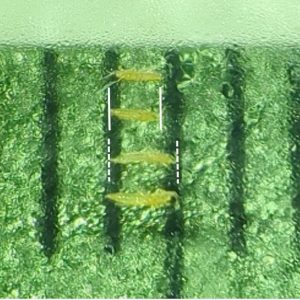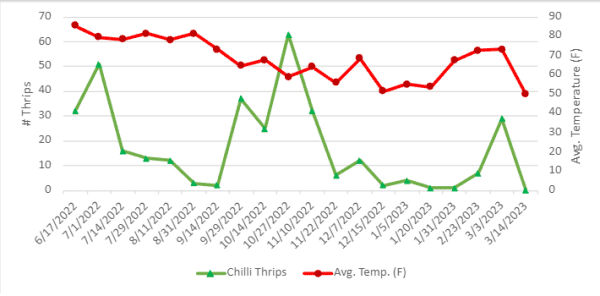Crop Production

Distribution in Alabama
Chilli thrips, Scirtothrips dorsalis, are important pests of ornamental, fruit, and vegetable crop production. Chilli thrips are likely native to Southeast Asia or India and first appeared in Florida in 1991. Since then, they have spread throughout Florida and into Georgia, Hawaii, Texas, and Alabama. Alabama has multiple confirmed records of chilli thrips in Mobile, Jefferson, Tuscaloosa, and St. Clair counties. These records begin in June of 2016 in Mobile County, with the most recent being in August of 2022 in Jefferson County. In November 2023, Aerianna Littler, a PhD student in the Department of Entomology and Plant Pathology, collected chilli thrips on azaleas and roses in Lee County. This population was identified and confirmed and the plants that were samples had damage consistent with chilli thrips. This is the first report of chilli thrips in Lee County and likely means they are established in neighboring counties as well. It is therefore important to be familiar with the life cycle, damage, and management of these thrips.
Life cycle
The life cycle stages of Scirtothrips dorsalis include feeding (larval stages and adults) and nonfeeding (egg and pupal) stages. Adult females use a saw-like ovipositor to cut and insert eggs into leaf tissues. Temperatures and plant species on which they feed are the important factors in outbreaks. Roses and peppers are among the host plants that enable the fastest development (approximately 18 days at 79°F). On average, they complete their life cycle in roughly 11 to 21 days. Females can reproduce at temperatures between 55 and 91°F but produce fewer eggs at higher temperatures.
Active chilli thrips in Auburn were collected on multiple days in December 2023 where overnight temperatures had been as low as 25°F. Additionally, there were several consecutive nights with below freezing temperatures just before the thrips were collected. The lowest survival temperature threshold for chilli thrips is not reported, but it is not supposed to survive areas with five or more nights less than 24.8°F (-4° C). Clearly in parts of Alabama chilli thrips populations are abundant and active during the winter months — especially on host plants that are evergreen (Indian hawthorn, cleyera) or that maintain some foliage throughout the cooler months (roses).
Identification

Figure 1. Size of chilli thrips (top two thrips) compared to other thrips (bottom two thrips). Black lines indicate 1-mm markings (photo credit: Aerianna Littler).
Field identification of chilli thrips can be difficult even with a hand lens due to their small size and fast movements. Adult chilli thrips are less than or equal to 1 millimeter (about the width of a tip of a ballpoint pen), mostly pale in color with triangular spots along the midline of their abdomen, and have dark wings. Their wings are long and fringed with long hairs but not very good for flight. Immature chilli thrips look like the adult form, but without wings.
How are they spreading around Alabama?
Chilli thrips can move locally by walking between plants that are touching or by flight. Thrips are poor fliers, and mainly just drift on wind currents. The dispersed county distribution in Alabama suggests that they are more widespread in the state than previously recorded, or because of movement of infested plant material. Because of their wide host range — once in the new location — they will likely find plants for feeding and oviposition.
Plant Hosts and Damage
Chilli thrips feed on over 100 plant species, meaning they are highly likely to find a plant on which they can survive in nurseries or in urban landscapes. Some ornamental plants that are commonly damaged are cleyera, rose, Indian hawthorn, aucuba, viburnum, and schefflera. They also commonly damage vegetable and fruit crops such as pepper, blueberry, bean, strawberry, and tomato. This species prefers to attack tender plant tissues such as fresh leaf growth, buds, flowers, and fruits, and is not typically found feeding on the older, more mature tissues.
Larvae and adult stages of chilli thrips have rudimentary sucking mouthparts that pierce leaf cells and suck out their contents. Feeding damage from Chilli thrips early in the season on evergreen and semi-evergreen plants may persist on those plants into the following growing season even after chilli thrips are gone. This confirms the importance of sampling to confirm that thrips are still present on damaged plants before applying insecticides.
Sampling
One useful method for detection is performing beat samples which involves beating plant leaves over a white surface such as a tray, frisbee, or a piece of paper. With this method, you can detect immature and adult stages. All stages are small and best seen with a hand lens. However, you can see adult chilli thrips moving on the white surface — looking like a moving comma. This method is cheap, quick, and provides numbers of thrips per plant.
Another method uses sticky cards. Adult chilli thrips are attracted to the colors blue and yellow, and yellow is a common sticky card color. Placing yellow sticky cards in or around host plants is a passive method of detection. Based on the length of their lifecycle and daily flight patterns, sticky cards could be used one day every two weeks between 9 a.m. and 4 p.m. However, this method will not capture the immature stages that do not fly. Our ongoing monitoring program near Mobile uses sticky cards to determine the seasonal activity of chilli thrips. Starting in June 2022, we have sticky card collections every two weeks. This program shows a few periods of high activity, such as March, June through July, then again in mid-September through mid-November. These are the times of year to be actively monitoring chilli thrips and limiting pruning or forcing new growth that may increase plant susceptibility. This research, supported by our USDA-NIFA Extension Implementation Program grant, will end in May 2024.

Figure 2. Abundance of Chilli thrips in and around nurseries in Mobile Alabama 2022-2023.
Management
Management practices could include cultural controls such as removal of weeds (potential hosts) and timing of pruning, use of biological controls such as predators and parasites/parasitoids, rotating chemicals by mode of action, or any combination of these practices.
Chilli thrips populations have developed insecticide resistance in parts of Asia and that could happen here. Toxicology experiments in strawberry crop in Florida have recently determined some level of resistance to insecticides when not utilized within a rotation. We can manage the development of resistance by following the label directions relative to use patterns and by changing the mode of action group for insecticides. The IRAC code is a set of numbers and letters that appear on most insecticide labels. The number stands for the mode of action group (how the insecticide kills thrips), and the letter is the chemical class. The best practice is to rotate insecticides with different modes of action (numbers). For example, insecticides with an IRAC code of 1A or 1B have the same mode of action, but 1A and 3A have different modes of action.
Table 1. Insecticides for Controlling Chilli Thrips
| IRAC Code | Trade Names of Insecticides for Nursery or Greenhouse Use |
|---|---|
| 1A | Sevin, Measurol |
| 1B | Orthene, Dursban, Duraguard |
| 3A | Pyrethroids such as Menace, Onyx Pro, Decathalon, Scimitar |
| 4A | Safari*, Marathon, Tri-star* |
| 4D | Altus |
| 5 | Conserve* or Entrust* |
| 6 | Avid* or Lucid |
| 15 | Novaluron |
| 29 | Aria* |
| Unknown or unclassified | Overture 35WP*, Botanigard, Azatin, Hort oils, or Insecticidal soaps |
Summary
Alabama has multiple counties with confirmed records of chilli thrips. This now includes Lee County and likely surrounding counties. Backyard gardeners, small fruit and vegetable producers, and ornamental nurseries and retailers should be on the lookout for these thrips and their damage in 2024.

